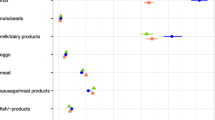Abstract
Objective
To examine the reproducibility of 24-hour dietary recall for estimating dietary vitamin intakes by middle-aged Japanese men and women.
Methods and Results
The subjects were 132 men and 130 women aged 40–69 years, selected from participants in cardiovascular risk surveys conducted in 4 communities. The reproducibility of the 24-hour dietary recall was tested by comparing nutrient and food intake for two recalls conducted on the same season 1 year apart, designated as recalls 1 and 2. Differences in mean values between two recalls were tested using analysis of variance, and Spearman rank correlation coefficients for the two recalls were calculated for nutrient and food intakes. Mean values of energy and vitamins for both sexes were generally similar for the two recalls. The reproducibility of recall by men was high for vitamin B2, folate, pantothenic acid, and vitamin C and by women for vitamin B2, moderate by men for vitamins A, E, K, B1, B6 and niacin, and by women for vitamins A, E, K, B1, B6 and niacin, folate, pantothenic acid and vitamin C, and low by both men and women for vitamins D and B12. The reproducibility during 1985-1999 was generally lower than that of 1973–1984, but that for folate, pantothenic acid and vitamin C remained to be moderate in 1984–1999.
Conclusions
Although the reproducibility of 24-hour dietary recall varies among vitamins, moderate and sustained reproducibility was observed for folate, vitamin C and pantothenic acid.
Similar content being viewed by others
References
Willet, W.C. Nutritional Epidemiology, 2nd ed. Oxford University Press, New York, NY. 1998.
Ministry of Health, Labor and Welfare. Nutrition Status Based on the National Nutrition Survey in Japan. 2001, Daiichi Shuppan. (in Japanese).
White paper on economics. 1987, Economic Planning Agency of Japan. (in Japanese).
White paper on the National Lifestyle. 1987: Economic Planning Agency of Japan. (in Japanese).
White paper on the National Lifestyle. 2005, Cabinet Office, Government of Japan. (in Japanese).
Iso H, Terao A, Kitamura A, Sato S, Naito Y, Kiyama M, Tanigaki M, Iida M, Konishi M, Shimamoto T, komachi Y. Calcium intake and blood pressure in seven Japanese populations. Am J Epidemiol 1991, 133:776–783.
Iso H, Sato S, Kitamura A, Naito Y, Shimamoto T, Komachi Y. Fat and protein intakes and risk of intraparenchymal hemorrhage among middle-aged Japanese. Am J Epidemiol 2003, 157: 32–39.
Yoshino K, Inagawa M, Oshima M, Yokota K, Umesawa M, Embo M, Yamagishi K, Tanigawa K, Sato S, Shimamoto T, Iso H. Trends in dietary intake of folate, vitamins B6, and B12 among Japanese adults in two rural communities from 1974 through 2001. J Epidemiol 2005, 15:29–37
Japan Science and Technology Agency. Standard Tables of Food Composition in Japan. The fifth revised edition: National Printing Breau, 2000. (in Japanese).
Willet WC, Stampfer MJ. Total energy intake: implications for epidemiologic analysis. Am J Epidemiol 1986, 124:17–27.
Sempos CT, Johnson NE, Smith EL, Gilligan C. Effects of intraindividual and interindividual variation in repeated dietary records. Am J Epidemiol. 1985;121:120–130.
Ogawa K, Tsubono Y, Nishino Y, Watanabe Y, Ohkubo T, Watanabe T, Nakatsuka H, Takahashi N, Kawamura M, Tsuji I, Hisamichi S. Dietary sources of nutrient consumption in a rural Japanese population. J Epidemiol. 2002, 12:1–8.
Imaeda N, Tokudome Y, Ikeda M, Kitagawa I, Fujiwara N, Tokudome S. Foods contributing to absolute intake and variance in intake of selected vitamins, minerals and dietary fiber in middle-aged Japanese. J Nutr Sci Vitaminol. 1999, 45: 519–532.
Author information
Authors and Affiliations
Corresponding author
Rights and permissions
About this article
Cite this article
Kubota, Y., Maruyama, K., Sato, S. et al. Reproducibility of 24-hour dietary recall for vitamin intakes by middle-aged Japanese men and women. J Nutr Health Aging 14, 196–200 (2010). https://doi.org/10.1007/s12603-010-0048-3
Received:
Accepted:
Published:
Issue Date:
DOI: https://doi.org/10.1007/s12603-010-0048-3




